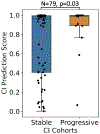Multi-label, multi-domain learning identifies compounding effects of HIV and cognitive impairment
- PMID: 34706304
- PMCID: PMC8678333
- DOI: 10.1016/j.media.2021.102246
Multi-label, multi-domain learning identifies compounding effects of HIV and cognitive impairment
Abstract
Older individuals infected by Human Immunodeficiency Virus (HIV) are at risk for developing HIV-Associated Neurocognitive Disorder (HAND), i.e., from reduced cognitive functioning similar to HIV-negative individuals with Mild Cognitive Impairment (MCI) or to Alzheimer's Disease (AD) if more severely affected. Incompletely understood is how brain structure can serve to differentiate cognitive impairment (CI) in the HIV-positive (i.e., HAND) from the HIV-negative cohort (i.e., MCI and AD). To that end, we designed a multi-label classifier that labels the structural magnetic resonance images (MRI) of individuals by their HIV and CI status via two binary variables. Proper training of such an approach traditionally requires well-curated datasets containing large number of samples for each of the corresponding four cohorts (healthy controls, CI HIV-negative adults a.k.a. CI-only, HIV-positive patients without CI a.k.a. HIV-only, and HAND). Because of the rarity of such datasets, we proposed to improve training of the multi-label classifier via a multi-domain learning scheme that also incorporates domain-specific classifiers on auxiliary single-label datasets specific to either binary label. Specifically, we complement the training dataset of MRIs of the four cohorts (Control: 156, CI-only: 335, HIV-only: 37, HAND: 145) acquired by the Memory and Aging Center at the University of California - San Francisco with a CI-specific dataset only containing MRIs of HIV-negative subjects (Controls: 229, CI-only: 397) from the Alzheimer's Disease Neuroimaging Initiative and an HIV-specific dataset (Controls: 75, HIV-only: 75) provided by SRI International. Based on cross-validation on the UCSF dataset, the multi-domain and multi-label learning strategy leads to superior classification accuracy compared with one-domain or multi-class learning approaches, specifically for the undersampled HIV-only cohort. The 'prediction logits' of CI computed by the multi-label formulation also successfully stratify motor performance among the HIV-positive subjects (including HAND). Finally, brain patterns driving the subject-level predictions across all four cohorts characterize the independent and compounding effects of HIV and CI in the HAND cohort.
Keywords: Alzheimer’S disease; HIV-associated neurocognitive disorder; MRI; Multi-domain learning; Multi-label classification.
Copyright © 2021 Elsevier B.V. All rights reserved.
Conflict of interest statement
Declaration of Competing Interest None of the authors have biomedical financial interests or conflicts of interest with the reported data or their interpretation.
Figures







Similar articles
-
Multi-auxiliary domain transfer learning for diagnosis of MCI conversion.Neurol Sci. 2022 Mar;43(3):1721-1739. doi: 10.1007/s10072-021-05568-6. Epub 2021 Sep 12. Neurol Sci. 2022. PMID: 34510292
-
Prediction of clinical and biomarker conformed Alzheimer's disease and mild cognitive impairment from multi-feature brain structural MRI using age-correction from a large independent lifespan sample.Neuroimage Clin. 2020;28:102387. doi: 10.1016/j.nicl.2020.102387. Epub 2020 Aug 19. Neuroimage Clin. 2020. PMID: 32871388 Free PMC article.
-
Deep Learning for Alzheimer's Disease Classification using Texture Features.Curr Med Imaging Rev. 2019;15(7):689-698. doi: 10.2174/1573405615666190404163233. Curr Med Imaging Rev. 2019. PMID: 32008517
-
Neuroimaging advances in neurocognitive disorders among HIV-infected individuals.Front Neurol. 2025 Feb 13;16:1479183. doi: 10.3389/fneur.2025.1479183. eCollection 2025. Front Neurol. 2025. PMID: 40017532 Free PMC article. Review.
-
Towards multi-label classification: Next step of machine learning for microbiome research.Comput Struct Biotechnol J. 2021 Apr 28;19:2742-2749. doi: 10.1016/j.csbj.2021.04.054. eCollection 2021. Comput Struct Biotechnol J. 2021. PMID: 34093989 Free PMC article. Review.
Cited by
-
Generating Realistic Brain MRIs via a Conditional Diffusion Probabilistic Model.Med Image Comput Comput Assist Interv. 2023 Oct;14227:14-24. doi: 10.1007/978-3-031-43993-3_2. Epub 2023 Oct 1. Med Image Comput Comput Assist Interv. 2023. PMID: 38169668 Free PMC article.
-
Metadata-conditioned generative models to synthesize anatomically-plausible 3D brain MRIs.Med Image Anal. 2024 Dec;98:103325. doi: 10.1016/j.media.2024.103325. Epub 2024 Aug 24. Med Image Anal. 2024. PMID: 39208560
-
Machine Learning Approaches to Understand Cognitive Phenotypes in People With HIV.J Infect Dis. 2023 Mar 17;227(Suppl 1):S48-S57. doi: 10.1093/infdis/jiac293. J Infect Dis. 2023. PMID: 36930638 Free PMC article.
-
Neurocognitive Latent Space Regularization for Multi-Label Diagnosis from MRI.Predict Intell Med. 2025;15155:185-195. doi: 10.1007/978-3-031-74561-4_16. Epub 2024 Oct 18. Predict Intell Med. 2025. PMID: 40365134
-
Imaging of Brain Structural and Functional Effects in People With Human Immunodeficiency Virus.J Infect Dis. 2023 Mar 17;227(Suppl 1):S16-S29. doi: 10.1093/infdis/jiac387. J Infect Dis. 2023. PMID: 36930637 Free PMC article. Review.
References
Publication types
MeSH terms
Grants and funding
- U01 AA017347/AA/NIAAA NIH HHS/United States
- R37 AA010723/AA/NIAAA NIH HHS/United States
- U24 AA021697/AA/NIAAA NIH HHS/United States
- R01 MH113406/MH/NIMH NIH HHS/United States
- P30 AG062422/AG/NIA NIH HHS/United States
- R01 NR015223/NR/NINR NIH HHS/United States
- R01 MH113560/MH/NIMH NIH HHS/United States
- K24 MH098759/MH/NIMH NIH HHS/United States
- F32 AA026762/AA/NIAAA NIH HHS/United States
- R01 AA017347/AA/NIAAA NIH HHS/United States
- U24 DA041123/DA/NIDA NIH HHS/United States
- U01 AA021697/AA/NIAAA NIH HHS/United States
- R01 AA010723/AA/NIAAA NIH HHS/United States
LinkOut - more resources
Full Text Sources
Medical

